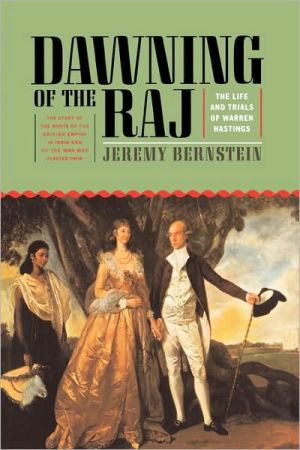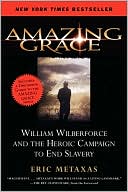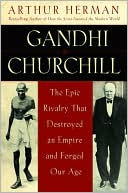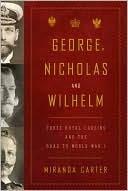Dawning Of The Raj
Nothing in the history of empire is stranger than the creation of British rule in India, when a small European island became master of a subcontinent ranging from the Indian Ocean to the Himalayas. In the late eighteenth century the person most responsible for this was Warren Hastings, Britain's first governor-general of India. In Dawning of the Raj, Jeremy Bernstein brings to life in vivid colors Hastings's story amidst the rise of British power. Orphaned early, Hastings worked his way up...
Search in google:
American retired theoretical physicist Bernstein, best known for his , describes the historical oddity of the tiny island of Britain becoming master of the huge tropical subcontinent of India. His story pivots on the career of Hastings (1732-1818), who made his way from the lowest clerk in the British East India Company to its highest office in Calcutta then returned to England and a seven-year trial for high crimes and misdemeanors. Annotation c. Book News, Inc., Portland, OR Booklist - Lay Freeman A jewel in the crown...this is an absorbing and stimulating book.
\ \ \ \ \ Chapter One\ \ \ PROLOGUE:\ GEORGE BOGLE\ \ \ \ The first Governor-General of India conceived the plan of opening friendly commercial intercourse between the people over whom he ruled and the natives of the lofty table-land behind the snowy peaks to the north. On this grand object Warren Hastings bestowed much thought and he gradually developed a policy which was continuous while his influence lasted. He took a broad and enlightened view of the requirements of the case, and he appears to have seen from the first that the end could only be gained by persistent efforts extending over a long period.\ It is owing to the absence of a continuous policy that this and many other great measures which were once full of promise have produced no permanent results.\ —Clements R. Markham, The Mission of George Bogle to Tibet and the Journey of Thomas Manning to Lhasa (1876)\ \ \ From early childhood I had the ambition—mainly from reading books—of going to the Himalayas. Growing up in Rochester, New York, and knowing no one else who thought this was reasonable, it seemed pretty far-fetched. Yet it came to pass not once but many times. In the fall of 1967, on assignment for the New Yorker, I spent several months in Nepal, both in Kathmandu and trekking to the base of Mount Everest and Annapurna. Then, in the fall of 1986, while trekking around the Annapurna range, I learned from people I met, who had just come back from Tibet, that that country had now opened itself up to more adventuresome tourism thansimply flying to Lhasa from central China on some sort of guided tour. Indeed, I discovered that it was now possible to drive from Kathmandu to Lhasa and then to make a loop to the Everest base camp in Tibet, and even to climb above the camp on the glaciers leading to the mountain itself. I decided that this was what I was going to do, and I managed to get an assignment to do it from the New Yorker. Thus it was in the spring of 1987 that I found myself once again in Kathmandu, but this time on my way to Tibet.\ Since I was planning to write about my trip, and about Tibet in general, I decided to spend the week or so I was in Kathmandu, before leaving, scouting bookstores and libraries to see if there were books about Tibet that I had not discovered. Kathmandu has some excellent bookstores that specialize in literature about the region, and there are also some wonderful libraries—both public and private—that do the same. As it happened, in 1967 I had made a friendship with a Nepalese man named Rishikesh Shaha, who had a great culture about both Nepal and the Indian subcontinent in general. He often wrote about these matters. Over the years I saw him whenever I came to Kathmandu. When I saw Rishikesh in the spring of 1987 I told him what I was planning to do. He then gave me the run of his library. Many of the books were familiar to me, but one of them, The Mission of George Bogle to Tibet and the Journey of Thomas Manning to Lhasa, was not at all. In truth, I had never heard of either of these men. Indeed, when I first skimmed the book it did not seem especially relevant to my interests. It had been published in 1876 and had been edited by a man named Clements R. Markham who identified himself as with the Geographical Department, India Office. It turned out that he was also the grandson of William Markham, who had been one of Bogle's colleagues in India. Markham's book was a labor of love.\ Bogle's trip to Tibet, the one described in the book, began in the late spring of 1774, and that of Manning's in 1811. The book also contains brief accounts of various other historical expeditions to Tibet. It was not obvious to me, at first, how any of this material bore on what I was about to do. But then I began reading it more carefully. While the rest of the book is certainly interesting, it is Bogle's journey, and his description of it, that stand out. Bogle's journal, which Markham publishes for the first time, was written fundamentally for an audience of one—Warren Hastings, the man who was responsible for Bogle's mission. By the time of his journey, Bogle knew Hastings well enough to know of his love of literature and language and of his interest in learning anything new about the people of India and their neighbors. One can imagine Bogle writing about Bhutanese women (the path to Tibet went through Bhutan) with Hastings in mind: "In all these different occupations of husbandry the heavy burden lies upon the fair sex; they have a hard lot of it. Besides all of this, the economy of the family falls to their share. They have to dress the victuals and feed the swine. They are not much troubled with washing or scrubbing: the fashion of the country renders this quite unnecessary. But not unfrequently one sees them with a child at the breast, staggering up a hill with a heavy load, or knocking corn, a labour scarcely less arduous. And with all this bitter draught they appear to have few of those sweetenings which might render it more palatable. They have none of the markets, fairs, churches, and weddings of England; they have none of the skipping and dancing of France; they have none of the devotion of the lower people in other Roman Catholic countries; they have none of the bathings, bracelets, &c., of the Bengali; and yet I know not how it comes to pass, but they seem to bear it all without murmuring; and having nothing else to deck themselves with, they plait their hair with garlands of leaves or twigs of trees. The resources of a light heart and a sound constitution are infinite." And so they are.\ George Bogle was the youngest of nine children—seven of whom survived—of George Bogle Sr. and Anne Sinclair. They were Scots, and Bogle was born on November 26, 1746, in Daldowie, the family seat near Bothwell on the right bank of the Clyde. Bogle's father was a successful Glasgow merchant who six times had been elected lord rector of Glasgow University. His mother, Anne, came from a distinguished Scottish family, the Sinclairs. Her father was a Scottish peer.\ Bogle appears to have had a very happy childhood. One of the letters Markham quotes is an early one he wrote from Calcutta to his sister Anne, who was known affectionately as Chuffles. In it he describes scenes from his early life. "Throwing myself back in my great chair," he writes, "I am transported to the nursery in Daldowie. The picture of Julius Caesar recalls to my mind the shows which you remember we used to make.... Do you remember how we broke open the window at the bottom of one of the beds, to get at some shells? Never shall I wish for anything so much as I did to get at those shells, which we could always see, and never get at. All was one continued scene of health and pleasure."\ Bogle studied briefly at Edinburgh University, but in 1764 he went to France where he traveled for a year. His brothers Robert and John were commercial people. John had established himself as a merchant in Virginia, and some thought was given to Bogle's joining him there. But it was decided that he should go instead to London where Robert was a partner in the firm of Bogle and Scott. He became a clerk in the firm's "counting-house"—that is, a junior accountant. He remained there for four years, and in 1769, through the influence of friends, he secured an appointment with the East India Company.\ The remarkable history of this company we will touch upon later, but here are a few useful facts. On December 31, 1600, in the last years of the reign of Queen Elizabeth I, 101 London merchants were granted a royal charter for "The Company of Merchants of London trading into the East Indies." This gave them exclusive rights to trade in the Far East for the next fifteen years. Of particular importance was that the company was to operate free of royal constraints. They were to be a law unto themselves. By Bogle's day the charter had been renewed several times, and "Merchants of London" had been replaced by "Merchants of England." It had become known as the East India Company, or simply as the Honourable Company. From very early in its history, the Company modeled itself in several ways after the Dutch East India Company, which had preceded it and with whom it had many military and nonmilitary confrontations. The Dutch had created municipal corporations—communities—in countries in the Far East where they did business. Following this model, in 1639 an agent of the East India Company, Francis Day, negotiated with the local ruler the right to build, on what was essentially an unoccupied beach, the municipal corporation that over the next decades became the city of Madras, one of the Company's footholds in India. The other two were Bombay and Calcutta.\ Bogle, like Hastings who had first arrived in India at the age of eighteen in 1750, entered the Company at the only rank possible, the lowest—that of "writer." This was a term of art which had been taken over from the Dutch "schryvers." The writers were clerks. They toted up accounts. In the records of the East India Company there are many hundreds of thousands of pages of these accounts. The writers worked in so-called "factories"—places where the trading was actually done. In Bogle's day this would have been trading in spices, cotton, and silk, as well as opium, which, it is said, was introduced into the Indian subcontinent from the Middle East by Alexander the Great in the fourth century B.C. It became the Company's principal export to China, where it was exchanged for tea.\ The writers were miserably paid—five pounds a year. A housemaid working in a manor house in England did not earn much less. The writers also had a monthly living allowance of twenty rupees (about two pounds), which allowed them just to get by. But if they survived the unhealthy climate for a few years (many didn't) and the other objective dangers, which included alcoholism, they stood to make themselves rich by trading on their own—encouraged by the Company—without paying taxes and duties to the local Indian rulers. They would then lend their rupee earnings to the Company in India and redeem the loans with interest in pounds when they returned to Britain. Often the sums involved came to hundreds of thousands of pounds, enough in some cases to buy a seat in Parliament. Thus it took some string-pulling to win an appointment as a writer, string-pulling that was done in London. Fortunately for Bogle, during the period in question a disproportionate amount of the string-pulling was done by and for Scots.\ The numbers are interesting. While one-tenth of the population of the British Isles were at this time Scots, about half of all the appointments of writers, cadets for the cadre of officers in the Company's army, and even assistant surgeons, were Scots. This was no accident. The Company always tried to curry favor with influential members of Parliament. In the mid-eighteenth century, Parliament succeeded in partially curbing the Company's independence. Without its influential Scottish supporters in Parliament, the Company's situation would have been much worse, as was later the case. That aside, it was in 1707 that Scotland had been incorporated into Britain, which made it possible for Scots to be employed by this chartered English company, and since many in the Scottish gentry were not well off, seeking one's fortune abroad was fairly common.\ Bogle's brother Robert no doubt had suitable connections. He presumably also had the wherewithal to underwrite Bogle's expenses in taking up his new position. These expenses included the cost of the passage by sail, which was typically more than a hundred pounds. There were also various items of clothing and even soap. One list I saw included a pound and a half for two wigs. I have never seen an eighteenth-century portrait of anyone from the Company in India wearing a wig. The tropical climate must have discouraged extraneous headgear, though wigs were worn by the imported British judges when they were hearing a case. In any event, Bogle embarked on January 25, 1770, on one of the Company's great sailing ships—"Indiamen" they were called, usually four or five hundred tons—the Vansittart.\ To better understand some of the rest of our story, it is important to realize what this sort of passage to India involved. It was the end of February before Bogle's ship cleared the English Channel. It did not arrive in Calcutta until August 19—seven months later. This was fairly typical. An extremely fast passage might be four months. Some passages landed—unwillingly when they were blown off course—first in Brazil before they turned east across the South Atlantic Ocean and around the Cape of Good Hope at the southern tip of Africa. Many vessels were lost in storms, and some were captured by hostile forces, such as the French. Markham does not tell us if Bogle went via Brazil, but he does tell us that after rounding the Cape the ship touched one of the Comoro Islands in the Indian Ocean. Then it went northeast across the Indian Ocean until it reached the coast of India. It made a stop at Madras and then sailed up the coast until it arrived at the mouth of the Hooghly River. Then it had to travel some eighty miles upstream to reach Calcutta. It is clear from this description that directing the activities of the Company from London in anything like real time was impossible. Decisions had to be made on the spot in India; the directors of the Company in London could react to them only months later—and, of course, vice versa. A year might go by before a response to a query, or an order, was received.\ The location of Calcutta upstream on the Hooghly was partly accident and partly design. The Hooghly is the westernmost channel in the delta by which the Ganges reaches the sea. It was, at the time, the main outlet for the river. It was more or less navigable by ocean-going ships up to about where Calcutta stands. But there is no obvious reason why this particular mud ridge was selected by the city's founder, Job Charnock, in 1690. Three nearby villages, Kalikata, Sutanuti, and Govindapur, all became parts of the city, which took its name from the first. As anyone who has visited Calcutta knows, the climate during the monsoon season, when the city becomes a kind of malignant Venice, borders on the insufferable. One can imagine British traders trying to flog their stout wool cloth—which at first they did—to the locals. What happened was the reverse. The British soon found themselves paying in silver, much of which came from Mexico, for the cottons and silks of India. "Calico" takes its name from Calicut, now officially Kozikode, an Indian city on the southwest coast.\ One of Hastings's biographers has given us a vivid description of Calcutta's appearance in the mid-eighteenth century. I offer this in some detail because most all Englishmen, including those who later were to judge Hastings in Parliament, had never been to India. They had no firsthand knowledge of what living there meant.\ "One edifice [Fort William], confronting the river, dominated the low-lying horizon, the citadel built by Charnock's successors to defend the infant settlement. There the Union Flag proudly waved from a lofty flagstaff, proclaiming the rule of English law. The long outer wall of Fort William was comparatively low, but inside, rising well above the houses that clustered about it on the flat bank, were the main buildings of the seat of government of the settlement, the Governor's House and the Factory offices, well designed buildings and worthy of their dignified function. Landing at the steps below the Fort, one passed by the watergate through the main entrance into the Factory, and thence into the heart of the settlement."\ The description goes on: "Behind the Fort was a wide promenade and to the southeast a large square open space known as the Park, in the middle of which a reservoir, known as the Tank, provided the settlement with its main water supply. The Park was the center of the little community. [Known as Tank Square, it is still there and is still widely used.] To the north, facing the Park, was the community church, and next to it the Writers' Building...." [This building now houses the departments of the government of West Bengal.] "Eastwards lay the Court-house ... southwards the Hospital and the Cemetery, whilst on all sides scattered about within easy reach of the Fort were the dwelling-houses of the principal members of the settlement, most of them three-storied buildings, and built in the typical English Georgian style of the period. The whole area was less than one square mile. Immediately beyond, principally to the north, lay the native town, already grown to a considerable size and increasing rapidly."\ All of this sounds almost Arcadian, but the description goes on: "Few places in the world could have held less attraction than eighteenth-century Calcutta for the refined and cultured Englishman fresh from home. Though Bengal has sometimes been called a Garden of Eden—for reason of its rich fertility—Calcutta was emphatically no paradise. As late as 1780 ... it was described by a visiting traveler as `that scattered and confused chaos of houses, huts, sheds, streets, lanes, alleys, windings, gutters, sinks and tanks, which, jumbled into an undistinguished mass of filth and corruption, equally offensive to human sense and health....'\ "The surrounding swamp was poorly drained, the jungle was malarious [sic], the innumerable ditches were cesspools, putrefying bodies of men and animals lay on the banks of the river and in the streets and watercourses, the only drains were open canals, the scavenging was done by jackals at night and by vultures, kites and crows by day, sanitation of even the most primitive kind was nonexistent, and even in the great tank, which provided the settlement with drinking-water, pariah dogs with mange were known at times to bathe and drink."\ How anyone survived this for very long is difficult to imagine. You couldn't even get away to the mountains during the hot season. The idyllic hill stations one associates with British India were a century in the future. It was commonly said that very few of the English arrivals survived more than three monsoons. What's more, when Bogle arrived in Calcutta in 1770 he was greeted by a desperate famine. He describes it vividly in a letter to his father written not long after he arrived in the city:\ "Last year the crops failed to an extent never known before in the memory of man, which has reduced the inhabitants to utmost distress. [According to different estimates, between a third and a half died.] The town was better provided for than most others, and yet it has suffered amazingly. The Governor [John Cartier] and Council had a magazine of grain with which they fed fifteen thousand every day for some months, and yet this could not prevent many thousands from dying of want, and the streets from being crowded with the most miserable objects. There were sometimes 150 dead bodies picked up in a day, and thrown into the river. In the country the distress was greater, as it was further removed from the sea and not so easily supplied from distant countries. Whole families perished of hunger, or fed upon leaves of trees, or, contrary to their religion, ate animal food; some even subsisted on the dead carcasses. Their distress is unparalleled, and it shocks one to think of it. A million and a half people are said to have famished in the provinces that belong to the English. There is one thing that must amaze everyone that has been used to a free country. There is an indolence and indifference about them that is astonishing, and despair rather increases it. They have died without a single effort to obtain grain either by force or even by toil and labour. What mobs and commotions there would be with us were grain to increase to three times its price! and in many places it was a hundred times what it usually is." By the following December the worst of the famine was over.\ Bogle, now approaching his mid-twenties, was a little older than the typical writer recruit. Perhaps it was because of this, or perhaps it was because his superiors realized his special abilities, that he was placed as an assistant with the so-called Select Committee, which transacted the political business of the Company. This gave him the opportunity to study how it operated. Like Hastings, but unlike most of his colleagues, Bogle began learning the languages of the subcontinent. At the time, Persian was the language of diplomacy in this part of the world—no doubt reflecting the fact that Bengal was part of the Moghul Empire. Urdu, now the national language of Pakistan, has an Arabic script and a plethora of Persian words. Both Bogle and Hastings learned Persian and Urdu. They certainly knew Bengali. This gave both of them an ease in dealing with the local people that most of their British contemporaries did not enjoy.\ After Bogle had been in Calcutta for eighteen months, Hastings arrived there from Madras where he had been stationed. He was about to take up his duties as the newly appointed governor of Bengal. From here on the careers of the two men became intertwined. In an attempt to rejuvenate a dormant bureaucracy, Hastings made a number of new appointments. Bogle became assistant secretary to the Board of Revenue. In this capacity he accompanied Hastings on a four-month visit to the interior of Bengal. It was at this time that Bogle's brother Robert suffered severe business losses, and it looked as if his father might have to sell their home at Daldowie. Bogle dedicated himself to earning enough money to pay off his family's debts. Over the next several years he managed to transmit 4,500 pounds—a very large sum—to his family. He was also steadily gaining the confidence of Hastings and moving up the Company ladder. One can see why Hastings might have chosen Bogle to lead the first British diplomatic mission to Tibet.\ To understand the events that led to this mission, we need to say a little about the geography and history of India's northern neighbor, Bhutan. If you fly north from Calcutta to Paro in Bhutan—the country's only airfield—you first fly over what appears to be the absolutely flat seabed of an ancient sea, which indeed it is. During the monsoon season this area is largely under water. But then one abruptly runs into the "coastline." This is a line of steeply rising Himalayan foothills which are densely covered by forests so thick that you cannot see the ground. The hills rise to about seven thousand feet and level off on a plateau, the first step to the Tibetan plateau which is over twelve thousand feet in altitude. At eighteen places river valleys cut through these foothills. These valleys are known as "duars"—related to the Hindi world dwar, for "gate," and to our own word "door." The duars provide the only viable passages from the plateau down to the plains of India.\ In the late eighteenth century Bhutan was not a unified country; it was split into various fiefdoms ruled by local warlords. The warlord who ruled from what is now the capital of Bhutan, Thimpu, became known to the British as the Deb "Raja." The northernmost border state of India, on the Bhutanese border, had the colorful name of Cooch Behar. It had its own raja. From time to time Bhutanese raiders came down the nearest duar and invaded Cooch Behar. In 1772 they abducted both the raja and his brother. The regent—the deputy ruler—of Cooch Behar, appealed to the British—in particular to Hastings, who was now the governor of Bengal—for help. He proposed to pay half the state revenues if the British could rid Cooch Behar of the invading Bhutanese. Hastings accepted—a pattern that would be repeated with other frontier states.\ In December 1772 a force of sepoys—mercenary Indian troops—under the command of Captain John Jones was sent into Cooch Behar to deal with the Bhutanese. They learned, as the British would continue to learn in the Duar Wars of the next century, that the Bhutanese were tough customers. With heavy losses on both sides, these skirmishes lasted into the spring of 1774 when the British finally administered a sound drubbing to the Bhutanese. The Deb Raja was forced to resign, and his successor began suing for peace. In the interim Hastings had been corresponding with the directors of the Company in London, partly to get permission for what he had already done during the interval between letters, and partly to promote the idea of trading with the Bhutanese and the Tibetans, something he had had in mind from the time he became governor of Bengal. Here, at last, might be a place to dispose of the heavy British woolen cloth.\ The Bhutanese, as Buddhists, had a spiritual allegiance to the Buddhists of Tibet. Nominally, the spiritual and temporal ruler of Tibet was the Dalai Lama in Lhasa. But at this time, as often happened, the Dalai Lama was a child, and a regent was the de facto ruler of the country. Next in line was a second lama, the Panchen Lama, whom the British usually referred to as the Teshu Lama (their own variant on the "tashi" or fortunate lama). The Panchen presided over the Tashilhunpo monastery near Shigatse, the second largest city in Tibet, some two hundred miles from Lhasa and that much closer to Bhutan. The Bhutanese were now intensely concerned about the intentions of the British, so they appealed to the Panchen whom they regarded as their protector. The Panchen had somehow heard of Hastings, and so it was, on March 29, 1774, that Hastings received a remarkable letter in Persian from Tibet. The letter has been variously translated, but I much prefer the savorous version in Markham's book.\ It begins, "The affairs of this quarter in every respect flourish. I am night and day employed in prayers for the increase of your happiness and prosperity. Having been informed by travellers from your quarter of your exhalted fame and reputation, my heart, like the blossom of spring, abounds with gaiety, gladness, and joy; praise that the star of your fortune is in its ascension; praise that happiness and ease are the surrounding attendants of myself and family. Neither to molest nor persecute is my aim; it is even the characteristic of my sect to deprive ourselves of the necessary refreshment of sleep, should an injury be done to a single individual. But in justice and humanity I am informed that you far surpass us. May you ever adorn the seat of justice and power that mankind may, under the shadow of your bosom, enjoy the blessings of happiness and ease."\ This out of the way, the Panchen now gets down to business. "By your favour, I am the Rajah and Lama of this country, and rule over numbers of subjects, a particular with which you have no doubt been made acquainted by travellers from these parts. I have been repeatedly informed that you have been engaged in hostilities against the Deb Judhur [the previous Deb Raja], to which it is said, the Deb's own criminal conduct, in committing ravages and other outrages on your frontiers, has given rise. As he is of a rude and ignorant race (past times are not destitute of instances of the like misconduct, which his own avarice has tempted him to commit), it is not unlikely that he has now renewed these instances; and the ravages and plunder which he may have committed on the skirts of the Bengal and Bahar [sic] provinces have given you provocation to send your vindictive army against him. However, his party has been defeated, many of his people have been killed, three forts have been taken from him, and he has met with the punishment he deserved; and it is as evident as the sun your army has been victorious, and that, if you had been desirous of it, you might, in the space of two days, have entirely extirpated him, for he had not power to resist your efforts."\ Now the admonition. "But I now take upon me to be his mediator, and to represent to you that, as the said Deb Rajah is dependent on the Dalai Lama, who rules in this country with unlimited sway (but on account of his being in his minority, the charge of the government and administration is committed to me), should you persist in offering further molestation to the Deb's country, it will irritate both the Lama and all his subjects against you. Therefore from a regard to our religion and customs, I request you will cease all hostilities against him, and in doing this you will confer the greatest favour and friendship upon me. I have reprimanded the Deb for his past conduct, and I have admonished him to desist from his evil practices in future, and to be submissive to you in all matters. I am persuaded that he will conform to the advice which I have given him, and it will be necessary that you treat him with compassion and clemency. As to my part, I am but a Fakir, and it is the custom of my sect, with rosary in our hands, to pray for the welfare of mankind, and for the peace and happiness of the inhabitants of this country; and I do now, with my head uncovered, entreat that you may cease all hostilities against the Deb in future...."\ This extraordinary document inspired Hastings to conclude a ten-article peace treaty with the Bhutanese in a matter of weeks. It restored some land that the British had taken from the Bhutanese in exchange for five Tangun ponies. These charming animals (Bogle was soon to make use of them) are one of the delights of anyone traveling in the backcountry of Bhutan, where they trot along with bells jingling. The Bhutanese were also allowed to send an annual trade delegation to the northern India border town of Rangpur. Peace was restored, and the scene was set for Bogle's mission. In Hastings's mind, Bhutan was now a sideshow. The real object was to open diplomatic relations with Tibet, which might in turn bring improved trade relations with China, an Eldorado promising untold riches to the Company.\ By mid-May 1774 Hastings had officially appointed Bogle as his "deputy to the Teshu Lama, the sovereign of Bhutan." In a footnote Markham suggests (and I agree) that by "Bhutan" he meant here bhot, a reference to Tibet and a transliteration of the Tibetan word for "Tibet"—pö, the origin of the name "Bhutan," land of the Bhots. Hastings uses "Bhutan" in this sense elsewhere. But he does not seem to realize that the Panchen is not in Lhasa where he proposes to send Bogle. He charges Bogle with investigating the prospects for trade in such items as "gold, silver, precious stones, musk," and "rhubarb." Bogle is also charged with studying the geography of the country—terra incognita to the British. Bogle is to report back "from time to time" on his progress. Hastings had the idea that Bogle might establish a "residence" in Lhasa—something that did not happen until the twentieth century and then only by force of arms. Hastings also asked Bogle to draw on him for all charges. It seems as if Hastings paid for this expedition out of his own funds. Finally, he appointed an assistant surgeon named Alexander Hamilton to go along on the mission. The two men would be without a military escort.\ This was the formal public letter of appointment. Three days later, however, Hastings sent Bogle a private commission which, in my view, illustrates Hastings at his best. This is what he asked Bogle to do:\ 1. To send one or more pair of animals called tús [goats] which produce the shawl wool. If by a dooley, chairs, or any other contrivance they can be secured from the fatigues and hazards of the way, the expense is to be no objection.\ 2. To send one or more pair of the cattle which bear what are called cowtails [yaks].\ 3. To send me carefully packed some fresh ripe walnuts for seed, or an entire plant, if it can be transported; and any other curious or valuable seeds or plants, the rhubarb and ginseng especially.\ 4. Any curiosities, whether natural productions, manufactures, paintings, or what else may be acceptable to persons of taste in England. Animals only that may be useful, unless any that may be remarkably curious.\ 5. In your inquiries concerning the people, the form of their government, and the mode of collecting their revenue, are points principally meriting your attention.\ 6. To keep a diary, inserting whatever passes before your observation which shall be characteristic of the people, the country, the climate, the road, their manners, customs, buildings, cookery, &c., or interesting to the trade of this country, carrying with you a pencil and a pocket-book for the purpose of minuting short notes of every fact or remark as it occurs, and putting them in order at your leisure while they are fresh in your memory.\ 7. To inquire what countries lie between Lhasa and Siberia, and what communication there is between them. The same with regard to China and Kashmir.\ 8. To ascertain the value of their trade with Bengal by their gold and silver coins, and to send me samples of both.\ 9. Every nation excels others in some particular art or science. To find out the excellence of the Bhutanese [Tibetans].\ \ Warren Hastings\ \ \ \ 10. To inform yourself of the course and navigation of the Brahmaputra, and of the state of the countries through which it runs. [This would have been quite a task, for the Brahmaputra has it source in far western Tibet, near Mount Kailas, and ends up draining in India not far from the border with Burma.]\ \ W.H.\ \ \ \ Not mentioned in the commission was Hastings's charge to Bogle to plant potatoes at every rest stop, which he faithfully did, noting the exact number in his journal. In addition, Hastings provided Bogle with an historical memorandum about Tibet which he wrote himself. He must have read quite widely in the sources available to him. But this only whetted his curiosity. He writes in one paragraph, "It is said that in Tibet it is very common for one lady to have several husbands. I should wish to know if this practice obtains in all ranks of society, and whether those husbands who all have intercourse with one woman have not likewise other women that are their wives, with whom likewise they hold an intercourse in common. We have instances in other countries where, though each man in a family had a wife that was properly his own, all the men in the family had likewise an intercourse with all the women in it. Perhaps this may also be the case in Tibet; and if we knew anything of the laws of succession in Tibet, or to whom the children of a wife with several husbands were understood to belong, one might be able to discover how the fact stood, though we had no direct information with regard to it."\ Armed with these instructions, Bogle and Hamilton left Calcutta in mid-May 1774 with a cadre of Bengali assistants, none of whom had ever seen snow, to follow a route that no Englishman had ever traveled. Their first destination was the Tashichodzong in what is now the present capital of Bhutan, Thimpu. In Tibetan, or Dzongkha, the national language of Bhutan, dzong refers to a fortress-monastery. The Tashichodzong, which the British called the Tassisudon, was the seat of the government of the Deb Raja. Its buildings, which are still on the same site but have been reconstructed several times, house the present Bhutanese government. One can drive in a day from the Indian frontier to Thimpu following a route up the Buxa Duar which, as far as I can tell, is the same one Bogle took. On foot and pony it took him ten days. His encounter with the Deb Raja was most cordial and led to the peace treaty mentioned above.\ The next step was to travel into Tibet to meet the Panchen. Here a snag developed. Communications arrived from Tibet saying that Bogle was not welcome and should return to India. Different excuses were offered: that an epidemic of smallpox made traveling into Tibet unsafe; that the Chinese, who were at this time enjoying a period of influence in Tibet, objected. Later Bogle discovered the real reason: the Panchen had been informed that two "Fringies"—foreigners—had arrived in Bhutan with a large retinue, the Bengalis. Having no experience with the British, the Panchen thought, reasonably, that this might be some sort of military expedition. In time it was reported to him that the group seemed to have only peaceful intentions, so they received permission to enter Tibet. By the time they left the country, it was October.\ To enter Tibet they crossed a high pass from which two of the most magnificent mountains in the world are visible. Chomolhari, at 24,000 feet, is on the Bhutan-Tibet frontier. It is a sacred mountain to the Bhutanese, and Bogle was warned not to try to hunt animals within view of it. But he also glimpsed what he describes as a "snowy hill." This, from its location on the frontier between Sikkim and Nepal, was surely Kanchenjunga (28,208 feet), the third-highest mountain in the world.\ The Panchen was not in Shigatse; the city was suffering a smallpox epidemic. So the two met in a small palace a day's march away from the city. They got along well at once. It turned out that the Panchen's mother was from Ladakh, close to India, so that he had learned Hindustani from her, a language that Bogle knew. From Bogle's journal it is clear that, by the time he left Tibet, he had made himself fluent in Tibetan.\ Bogle spent more than five months in Shigatse with the Panchen and his family. His description of his stay is one of the high points of the journal. When he was not having long talks with the Panchen, he passed the time playing chess or fortune-telling or in like activities. "... The Tibetans have a great faith in fortune-telling," Bogle writes, "which indeed seems to be common to all mankind except our European philosophers, who are too wise to believe in anything." On one occasion the Panchen asked Bogle to describe Europe to him. He was particularly interested in Russia. The Russians and Chinese were then engaged in border skirmishes. (In the next century this would become the Great Game, with the British drawn in as well. It would become the excuse for the 1904 British invasion of Tibet.) The Panchen also wanted to know about the Christian religion. Jesuits had entered Tibet earlier in the century but had been expelled from the country. The Panchen asked Bogle to explain the Trinity. Religion was not Bogle's strong suit, and he did not feel up to the task. But when the Panchen asked Bogle to say something in English so that he could hear what the language sounded like, Bogle recited some verses of Gray's "Elegy in a Country Churchyard."\ Meanwhile he was reporting continually to Hastings about what he was learning. On the polyandry he noted, "Montesquieu and other political writers insist that it is destructive of the population; and the women cry out that it is unjust and unreasonable that so many of their sex should be subjected to the pleasure of one man. But in this country they have their revenge. The elder brother marries a woman, and she becomes the wife of the whole family. They club together in matrimony as merchants do in trade. Nor is this joint concern often productive of jealousy among the partners. They are little addicted to jealousy. Disputes, indeed, sometimes arise about the children of the marriage; but they are settled either by a comparison of the features of the child with those of its several fathers, or left to the determination of the mother."\ The Panchen made a request which Bogle passed on to Hastings. There had been a Buddhist temple in Calcutta that had been destroyed when the Muslims had taken Calcutta for a time from the English. Could the governor have a new one built? As soon as he learned of the Panchen's request, Hastings ordered a Buddhist temple and center for Buddhists built on the banks of the Hooghly. But if Bogle hoped for a visit to Lhasa, it could not be arranged. The politics were simply too complicated, and while the Panchen was agreeable, the people in Lhasa were not.\ In early April 1775 Bogle began his return trip, covering essentially the same route he had traveled a year before. By June he was in India. Markham quotes an excerpt from a letter that Bogle received from Hastings upon his arrival: "I am perfectly satisfied and pleased with every circumstance of your conduct, and equally so with the issue of your commission.... I have many thanks to make for your journal, which the world must have. Its merits shall not be lost where I can make it known...." True to his word, on August 7, 1775, a scant few weeks after Bogle's return, Hastings wrote to Samuel Johnson, whom he had gotten to know in London, enclosing a copy of Bogle's journal. "When I read the account of your visit to the Hebrides," he wrote, "I could not help wishing that a portion of that spirit which could draw so much entertainment and instruction from a region so little befriended by nature, or improved by the arts of society, could have animated Mr. Bogle, the author of this journal, but I flatter myself that you will find it not unworthy of perusal. I confess I received great pleasure from it, and I assure myself, that whatever originality you may discover in the description of the countries and inhabitants of which it treats, you will at least be pleased with the amiable character of the Lama, which has been confirmed to me by the testimonies of other travellers, who have visited his capital...."\ Hastings goes on: "I am afraid it may look like an ill compliment to tell you that I have endeavoured to prevail on the writer to put it into a more connected form, and to send it, with some additional materials, to England for publication. If it would not be assuming too great a liberty, I should request to be favoured with your opinion upon the propriety of this intention. The first copies of these sheets were taken, and intended for your perusal, long before I had any thoughts of making them public, and I cannot now deny myself the satisfaction of accomplishing that design whatever may be their future lot...."\ Nothing came of this request, and the journal was not published until a century later.\ \ \ * * *\ \ \ TO EXPLORE the details of the next six years of Bogle's career, when his destiny became interwoven with that of Hastings, would get us ahead of our story. Here let me note that in or around 1775, Bogle's portrait was painted by the English artist Tilly Kettle, who was then living in India. It is the only portrait of Bogle I have seen. But Kettle's portraits of Hastings are so much like the other paintings of him that I would assume that this is a good likeness of Bogle as well. He is shown in what appears to be a Bhutanese outfit. He has bare feet and is wearing a hat that resembles a flower pot. Two Tibetans seated next to him are smoking pipes. Through the open window one can see a monastery. The setting does not look much like Shigatse, but Kettle would not have had much visual documentation to work with.\ In 1779 Hastings appointed Bogle collector of revenue in Rangpur, a town on the Bengal-Bhutan frontier. Then, in 1781, Hastings promoted Bogle to be a member of the Committee of Revenue in Calcutta. He immediately took up the position, but shortly after he arrived in Calcutta he contracted a fatal illness and died on April 3, 1781. He was thirty-four. He is buried in the South Park Street Cemetery in Calcutta, where there is a massive monument in the form of a sarcophagus with a simple dedication to the "Late Ambassador to Tibet." Had Bogle lived, Hastings planned to send him back to Tibet on a second mission, this time all the way to Lhasa.\ When I first read Markham's account of Bogle's death, I was puzzled by this passage: "George Bogle left two daughters, named Martha and Mary, who were sent to Scotland...." Why no mention of the girls' mother? Who was she? This was a complete mystery to me until I came across a memoir entitled "George Bogle and his Children" written by H. E. Richardson, who was the last British Resident in Lhasa before the Chinese takeover of Tibet in the 1990s. In his book Tibet and Its History, Richardson had described a startling discovery about Bogle's children, and this memoir brought the story up to date. Richardson had come across evidence that the girls' mother was a Tibetan who may well have been related to the Panchen. It was even suggested that she was the Panchen's sister, something that Richardson thinks was impossible. It may have been one of the nieces whom Bogle writes about affectionately. She must have come back with him from Tibet. That the girls had a Tibetan ancestry was, it turned out, part of the Bogle family legend. Markham must have known this, because in reconstructing Bogle's journal he spoke with members of the family. But to the Victorians this sort of liaison was not something to be discussed. Indeed, as Richardson notes, there is evidence that Bogle had had other children with native women before his relationship with his Tibetan wife. This too was not to be discussed, though in Bogle's day it was commonplace.\ When I first encountered Bogle's journal in Rishikesh Shaha's library, all those years ago, I read it with the eye of a traveler, on my way to Tibet. Warren Hastings for me was, at the time, a secondary figure. What I knew about him I had learned from Bogle's journal. But over the years I found myself haunted by him. I kept asking myself, why was this man brought into disgrace? Was Bogle completely wrong in his assessment of him? Who was Hastings? How did he come to cast such a giant shadow over a country like India? That is the mystery we now begin to unravel. It has taken me a decade.
Prefaceix1Prologue: George Bogle32A Biblio-Biographical Interlude243Hastings, 1732-1769304Hastings, 1769-1772: Madras575Hastings in Bengal, 1772-1774696Hastings, 1774-1785827The Diaries of Fanny Burney1788The Trial of Warren Hastings2039Epilogue: Final Years265Notes291Bibliography305Index309
\ The Wall Street JournalComprehensible, entertaining, and accurate...an impressive book!\ — Andrew Roberts\ \ \ \ \ London Review of BooksA useful reminder of the vicissitudes of global power.\ — Brian Young\ \ \ BooklistA jewel in the crown...this is an absorbing and stimulating book.\ — Lay Freeman\ \ \ \ \ London Review Of BooksA useful reminder of the vicissitudes of global power.\ — Brian Young\ \ \ \ \ The SpectatorThis is an excellent, lucid book on a difficult subject...readable and interesting.\ — Phillip Hensher\ \ \ \ \ Wall Street JournalComprehensible, entertaining, and accurate...an impressive book!\ — Roberts, Andrew\ \ \ \ \ Andrew RobertsComprehensible, entertaining, and accurate...an impressive book. \ — Wall Street Journal\ \ \ \ \ Lay FreemanA jewel in the crown...this is an absorbing and stimulating book. \ — Booklist\ \ \ \ \ Brian YoungA useful reminder of the vicissitudes of global power. \ — London Review of Books\ \ \ \ \ HensherThis is an excellent, lucid book on a difficult subject...readable and interesting. \ — The Spectator\ \ \ \ \ Publishers WeeklyAcclaimed biographer Bernstein (Albert Einstein and the Frontiers of Physics) looks at the history behind the impeachment trial of the 18th century--a trial that lasted seven years, involved some of the epoch's greatest figures (Edmund Burke, Richard Sheridan) and ended in acquittal. At the center of these events was the colonialist Warren Hastings--India's first British governor-general. Hastings, Bernstein claims in this descriptive account, was the man responsible for planting the seeds of the British Empire in India. A brilliant, intellectually curious man, Hastings ruled India arrogantly, efficiently and by personal decree; he set up a postal service, sponsored a geographical survey of India's vast regions, unified the currency system, sponsored a diplomatic mission to Tibet and encouraged the codification of Indian law. But he served two demanding, and often contradictory, masters: the British East India Company and the British government. When, in the late 18th century, the East India Company sent "Company men," such as Philip Francis, overseas, most of them believed Hastings was an autocrat who needed to be reined in. That's when Hastings's troubles began. Drawing on his powerful friends back in Europe, Francis began a successful campaign to besmirch Hastings's reputation, and when Hastings returned home in 1785, he was charged with taking bribes, profiteering and genocide. Although occasionally lacking in narrative focus, this thoroughly researched, rich chronicle recalls an important chapter of European history, providing a fresh perspective on the roots of the British Empire and the labyrinthine politics of late-18th-century Britain. B&w photos. (May) Copyright 2000 Cahners Business Information.\|\ \ \ \ \ Internet BookwatchThe life and trials of Warren Hastings are followed in this story of early British rule in India, recommended for students of India history and for those researching early legal issues. Dawning of the Raj reads like a novel at times but is packed with facts about the trials of Warren Hastings, following the man's life and achievements.\ \ \ \ \ Kirkus ReviewsAn odd mix of conversational commentary and detailed historical documentation that presents an account of burgeoning British imperialism in India. One might wonder how theoretical physicist, mountain climber, and science writer Bernstein (Cranks, Quarks and the Cosmos, 1992, etc.) came to write an 18th-century colonial history. His prologue informs the reader that he stumbled across Hastings' story while reading regional history in preparation for a trip to (and a subsequent New Yorker story about) mountain climbing in Tibet. Hastings spent most of his life, from his teens on, employed by the British East India Company, rising through its ranks and finally achieving the rank of Governor-General of India. At the pinnacle of his power, he sponsored the development of the first Grammar of the Bengal Language and the first translation into English of the Bhagavadgita. After 12 years as Governor-General, however, he was recalled to Britain in disgrace to face impeachment charges for bribery, corruption, and oppression of the Indian people. The tension generated by these seemingly contradictory historical views of Hastings drives Bernstein's narrative, which is loaded with excerpts from primary-source documents. The best sections harness these sources to present sparkling and insightful profiles of peripheral figures (such as novelist Fanny Burney). More often, however, these sources strain against the weight of anachronistic colonial and parliamentary contexts. Bernstein's conversational prose avoids deep analysis of these complex contexts by adopting an apologist's stance for Hastings—giving the story a novelistic (rather than a historic) feel. Bernstein's decisiontofilter the broader history of the region through the prism of Hastings' life results in a narrative that lacks objectivity and strains beneath the weight of extensive documentation, but it is still interesting for its entertaining portraits of period figures. (21 b&w photos)\ \








